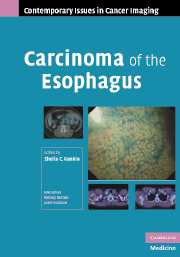Book contents
- Frontmatter
- Contents
- Contributors
- Series foreword
- Preface to Carcinoma of the Esophagus
- 1 Epidemiology and Clinical Presentation in Esophageal Cancer
- 2 Pathology of Esophageal Cancer
- 3 Recent Advances in the Endoscopic Diagnosis of Esophageal Cancer
- 4 Endoscopic Ultrasound in Esophageal Cancer
- 5 CT in Esophageal Cancer
- 6 FDG-PET and PET/CT in Esophageal Cancer
- 7 The Role of Surgery in the Management of Esophageal Cancer and Palliation of Inoperable Disease
- 8 Chemotherapy and Radiotherapy in Esophageal Cancer
- 9 Role of Stents in the Management of Esophageal Cancer
- 10 Lasers in Esophageal Cancer
- Index
- References
5 - CT in Esophageal Cancer
Published online by Cambridge University Press: 08 August 2009
- Frontmatter
- Contents
- Contributors
- Series foreword
- Preface to Carcinoma of the Esophagus
- 1 Epidemiology and Clinical Presentation in Esophageal Cancer
- 2 Pathology of Esophageal Cancer
- 3 Recent Advances in the Endoscopic Diagnosis of Esophageal Cancer
- 4 Endoscopic Ultrasound in Esophageal Cancer
- 5 CT in Esophageal Cancer
- 6 FDG-PET and PET/CT in Esophageal Cancer
- 7 The Role of Surgery in the Management of Esophageal Cancer and Palliation of Inoperable Disease
- 8 Chemotherapy and Radiotherapy in Esophageal Cancer
- 9 Role of Stents in the Management of Esophageal Cancer
- 10 Lasers in Esophageal Cancer
- Index
- References
Summary
Introduction
Cross-sectional imaging with computer tomography (CT) and magnetic resonance imaging (MRI) has no significant role in diagnosing esophageal cancer, although it is complementary to endoscopy, barium studies, endoscopic ultrasound (EUS), and positron emission tomography (PET) imaging in the staging of esophageal cancer. Accurate staging is necessary in order to prompt appropriate curative or palliative therapy. While CT and MRI are insensitive for delineating tumor invasion into and through the esophageal wall, these modalities play a role in estimating the esophageal tumor bulk, evaluating for local spread into adjacent structures, and diagnosing distant metastases, when present. Cross-sectional imaging also has an important role in the follow-up of esophageal cancer patients after treatment, to assess response to chemoradiotherapy and to evaluate recurrence after treatment.
Anatomy and staging
Knowledge of esophageal anatomy is important both for understanding how esophageal cancer spreads and for staging purposes. The esophageal wall consists of four layers: mucosa, submucosa, muscularis propria, and adventitia (Figure 5.1). There is no serosa to serve as a barrier between the esophagus and the surrounding structures; lack of a serosa facilitates tumor spread through the esophageal wall into adjacent structures. A rich plexus of lymphatics encircles the entire length of the esophagus, enabling lymphatic spread of tumor to mediastinal, cervical, and upper abdominal lymph nodes (Figure 5.2). An experimental study showed that dye injected into the esophageal wall at one level may drain to lymph nodes at all other levels of the esophagus in some patients and also frequently drains directly into the thoracic duct, potentially leading to hematogenous metastases.
- Type
- Chapter
- Information
- Carcinoma of the Esophagus , pp. 62 - 84Publisher: Cambridge University PressPrint publication year: 2007



